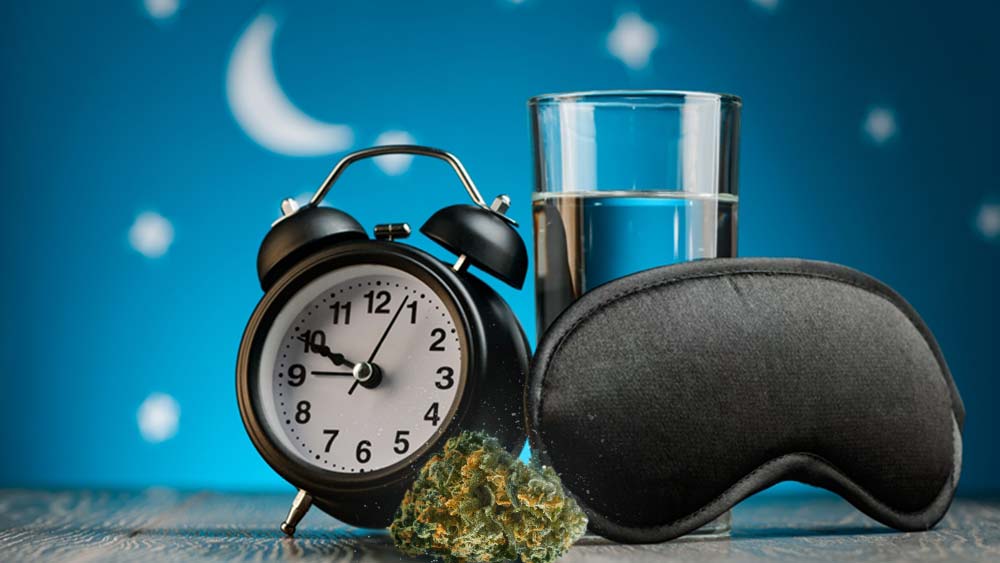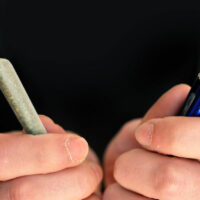Using cannabis prior to sleep can result in a number of different outcomes, because the entire process depends on numerous elements.
These elements include the type and quantity of cannabis, your personal psychological characteristics and biology, the longevity of use and potential dependence.
Most people that are looking to implement cannabis in their nighttime routine experience disorders or conditions that prevent them from having a good night’s rest.
Disorders related to sleep have skyrocketed in the 21st century, and some estimates suggest that between 50 and 70 million Americans suffer from some sort of a sleep-depriving condition.
Since medical and recreational cannabis is readily available in many places in Northern America, a great number of individuals are giving weed a shot.
But for most people, successfully implementing cannabis for sleep is not as easy as it looks.
What does smoking weed before bed do?
This question heavily depends on the type of cannabis used, the quantity consumed and the individual characteristics of the consumer.
Modern science doesn’t acknowledge the differences between Sativas and Indicas. All of the scientific studies that analyze the correlation between cannabis and sleep were using an undisclosed type of weed, which is a pretty absurd situation.
Even though they are both cannabis plants, Sativas and Indicas are quite different.
Their appearance, height, leaf shape and time required to flower are different, but most importantly, the effects they produce are very different.
The way a specific cannabis plant will affect us depends on two types of compounds, cannabinoids and terpenes.
An average cannabis plant has over a hundred different cannabinoids embedded in its structure, and a large number of different terpenes.
THC is undeniably the most abundant cannabinoid in both Sativas and Indicas, and therefore they both produce a unique psychoactive cerebral effect, colloquially known as the “high”.
But, the quantity of other minor cannabinoids and terpenes greatly differs between Sativas and Indicas, and this is why the effects they produce are so different.
People tend to forget the cannabis plant is ancient compared to humans (fossilized remains suggest that it’s at least 19.6 million year old), and Sativa and Indica subspecies have also existed for a really long time.
Long story short, pure Sativas are energizing and invigorating like a strong cup of coffee, and Indicas are sedative (containing terpenes such as myrcene, terpinolene and phytol).
If you’re looking to implement weed for better sleep, use Indicas exclusively as they are naturally calmative.
Avoid hybrids for sleep as they are man-made genetic amalgamations, and are typically bred to exhibit traits of both Sativas and Indicas.
Dosing weed before bed
Dosing weed before bed is complicated, because people react to the psychoactivity of cannabis very differently.
The current consensus is that this is partially due to hereditary genetic differences between people, but personal psychological traits also play a great role.
Some people tend to get restless and uneasy from very miniscule amounts of THC, while others can easily withstand really large quantities without any adverse mental effects.
The phrase “start low and go slow” is very useful for cannabis newbies, as it greatly diminishes the risk of overdoing it.
Since dosing is such a complex topic, for a broad and detailed overview on dosages for sleep you should check out our free Dosing Guidebook, which was produced in collaboration with Dr Dustin Sulak, who is a Maine-based cannabis clinician with an extensive decade-long experience.
A starting dose for only THC is 2.5 mg, for THC and CBD combined is 5 mg (2.5 mg THC plus 2.5 mg CBD), and for CBD alone it is also around 2.5 mg.
How long before bed should you stop smoking weed?
One of the main psychoactive properties of cannabis is that it makes our thoughts race.
This effect is attributed to THC, and this compound lessens the “break-time” between neurons firing, resulting in a mind that is working very rapidly.
Relaxing Indica strains produce sedation in the body and the famous “couch-lock” effect (where the consumer is “glued” to the couch), but even though the user is generally serene, the mind will still be racing, especially in the first hour or so.
Because of this, it is unrealistic to expect falling asleep right after a smoking/vaping session, as some time is usually required for the peak of psychoactivity to wear off.
This may be half an hour for some, but most people require at least an hour to become breezy enough in order to fall asleep.
It’s generally advised to do something relaxing to pass the time while the high wears off, like watching something on Netflix or reading a book, although I usually have a hard time focusing on a book while the psychoactivity is in high gear.
Finding your individual sweet spot can definitely take a while to perfect, but the entire process will go much smoother if you abide by these generalized “rules”, both for dosing and timing.
Cannabis tolerance
Another important factor to consider is cannabis tolerance.
Frequent consumption over extended periods of time usually results in an increased tolerance to cannabis, which basically implies that additional quantities are required for achieving the desired effect.
Tolerance breaks are a great way to avoid this adverse effect. For sleep-related use, laying off cannabis at least once every couple of nights is a great way to prevent getting your tolerance increased.
This research (1) indicated that a large percentage (39%) of everyday cannabis users start experiencing insomnia once they discontinued their cannabis use.
In order to prevent developing potential sleep disorders from cannabis, make sure to take tolerance breaks every time an adequate opportunity presents itself.
Weed hangovers
Cannabis hangovers seem to affect only a portion of cannabis consumers, where after a night of cannabis consumption the user feels sluggish, lethargic and generally groggy during the following morning.
Even though there’s still no definitive scientific reason to why some people have weed hangovers and others don’t, it’s fairly simple to assess what category you fall into.
If you are prone to weed hangovers, the best way to diminish this effect is to use cannabis responsibly, combining a carefully selected and thought-out dose with frequent tolerance breaks.
CBD before bed
If you’re looking to avoid the psychoactivity associated with regular cannabis (more precisely the main psychoactive constituent THC), the CBD cannabinoid (cannabidiol) doesn’t alter our consciousness, and can also be utilized for sleep related issues.
There is substantial evidence that CBD is beneficial for anxiety, depression and insomnia, and these disorders are one of the main reasons why people have issues with sleeping in the first place.
Research (2) has shown that a significant percentage of individuals with insomnia and greater sleep latency experienced relief when self-medicating with high-CBD strains.
Another review (3) was looking into the efficacy of CBD for insomnia, and found that cannabidiol definitely has therapeutic potential for treating this disorder.
The researchers from this study added that CBD is also potentially beneficial for REM (rapid-eye-movement) disorders and excessive daytime sleepiness.
How long before bed should I stop smoking weed in order to dream?
One of the strangest effects of cannabis is that it temporarily removes dreams out of the equation.
The vast majority of users (myself included) don’t remember their dreams after a nightcap cannabis session.
THC actually prolongs slow-wave sleep (4), which is the deepest stage of sleep, and subsequently lessens the time we spend in the REM phase, where dreaming occurs.
This reduction of the REM phase (5) benefits PTSD (6) sufferers the most, as they frequently relive past trauma through nightmares.
Another fascinating aspect of of the THC-dreams correlation is the so-called “dream pile-up”, or the “rebound effect”.
After a user takes a break from cannabis that contain THC, the quantity (and sometimes the intensity of dreams) is increased.
This effect can be pretty overwhelming, and in order to prevent a colossal dream pile-up make sure to take frequent tolerance breaks.
To conclude, don’t expect to dream if you’ve been using cannabis that night, and if you want to regain the connection to your subconscious, briefly abstain from weed and you’ll be just fine.
References:
- Deirdre A. Conroy PhD, Megan E. Kurth MPH, David R. Strong PhD, Kirk J. Brower MD & Michael D. Stein MD; Marijuana use patterns and sleep among community-based young adults; Oct 2014; 135-143
- Katherine A.Belendiuk, Kimberly A.Babson, Ryan Vandrey, Marcel O.Bonn-Miller; Cannabis species and cannabinoid concentration preference among sleep-disturbed medicinal cannabis users; November 2015; 178-181
- Babson KA, Sottile J, Morabito D; Cannabis, Cannabinoids, and Sleep: a Review of the Literature; April 2017
- Irwin Feinberg M.D., Reese Jones M.D., James M. Walker M.S., Cleve Cavness B.A., Jonathan March; Effects of high dosage delta‐9‐tetrahydrocannabinol on sleep patterns in man; April 1975
- Schierenbeck T, Riemann D, Berger M, Hornyak M; Effect of illicit recreational drugs upon sleep: cocaine, ecstasy and marijuana; October 2008
- George A. Fraser; The Use of a Synthetic Cannabinoid in the Management of Treatment‐Resistant Nightmares in Posttraumatic Stress Disorder (PTSD); February 2009







